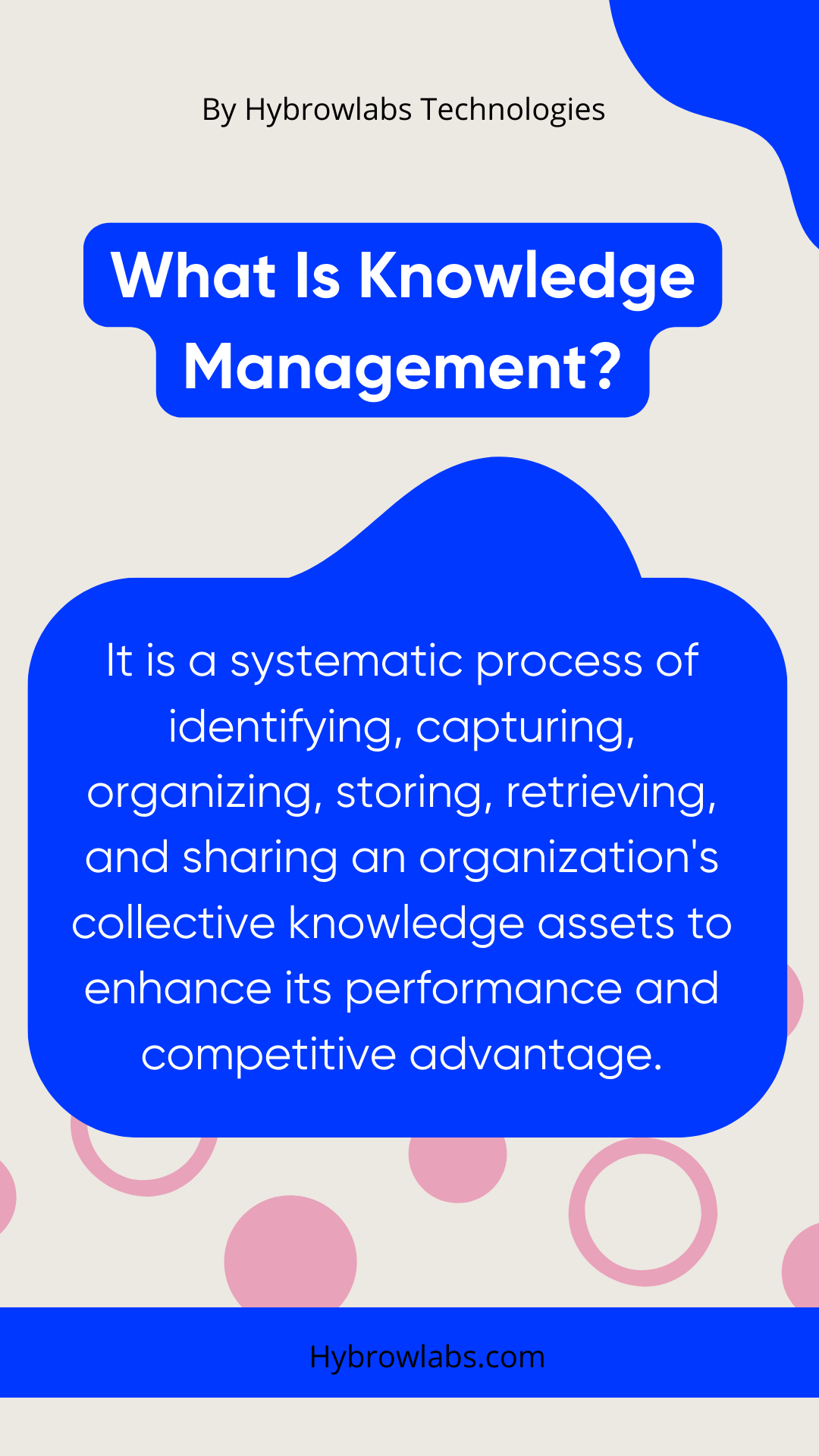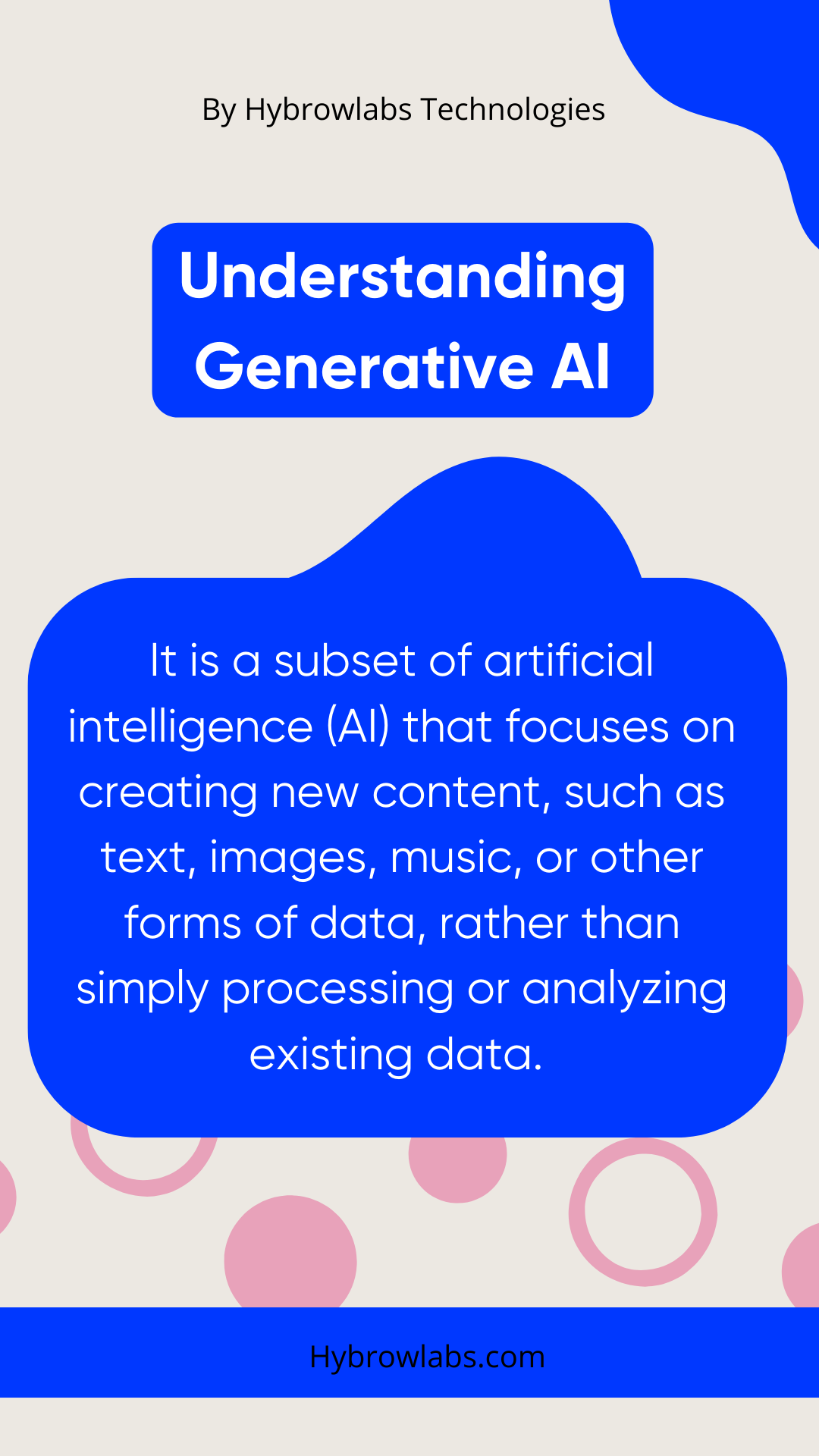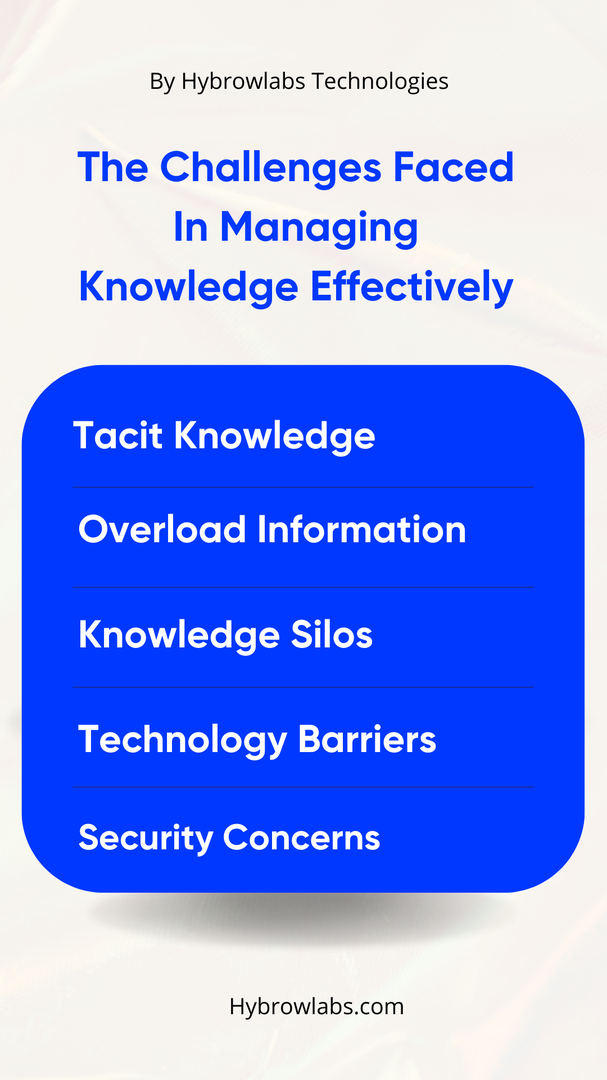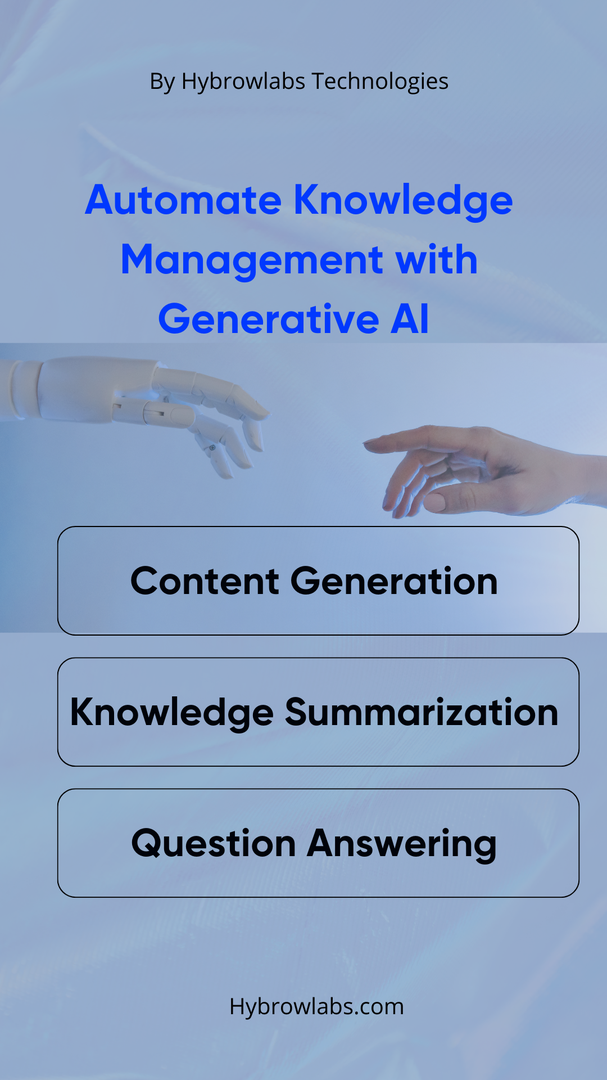Knowledge Management with Generative AI
Explore the Transformative Power of Generative AI in Knowledge Management, from Data Quality to User Acceptance, to Boost your Business Growth.
In today's fast-paced digital landscape, where information flows like a mighty river, harnessing the power of knowledge has become the key to success. Enter the dynamic duo of Knowledge Management & Generative AI, a fusion that's revolutionizing how we capture, organize & leverage information. Think of having a tireless assistant at your fingertips, capable of not only sifting through mountains of data but also generating valuable insights, ideas & solutions. In this blog, we'll discuss Knowledge Management with Generative AI, exploring the secrets to smarter decision-making, enhanced productivity & innovation like never before.
So, let’s start by knowing
What Is Knowledge Management?

Knowledge Management (KM) is an organized method of identifying, capturing, organizing, storing, retrieving & sharing an organization's collective knowledge assets to improve its performance & competitive advantage. It involves the strategies, processes & technologies used to build, store & distribute knowledge within an organization, assuring that information is available to the correct people at the right time.
Here are some key objectives of Knowledge Management:
1. Knowledge Creation:
One of the primary objectives of KM is to foster the creation of new knowledge. This involves encouraging employees to share their expertise, experiences & insights, which can lead to the development of innovative ideas & solutions. KM helps convert tacit knowledge (personal insights) into explicit knowledge (documented & shared information).
2. Knowledge Capture:
KM aims to capture & document the knowledge residing within an organization, whether it's in the form of documents, databases, or the expertise of employees. This ensures that valuable information isn't lost when employees leave or retire & that the organization can build on its existing knowledge base.
3. Knowledge Organization:
Effective KM systems organize knowledge in a structured & easily accessible manner. This includes creating taxonomies, categorizing information & establishing metadata to make it simpler for employees to find relevant data when needed.
4. Knowledge Storage:
KM involves storing knowledge in repositories such as databases, content management systems & knowledge bases. These repositories provide a centralized location for knowledge assets, making them readily available to employees.
5. Knowledge Sharing:
KM promotes a knowledge-sharing culture within an organization. This involves creating platforms & mechanisms for employees to exchange information, collaborate & learn from each other. This sharing of knowledge fosters a more informed & skilled workforce.
The Traditional Methods And Tools Used For Knowledge Management:
Traditional methods & tools for knowledge management have been employed by organizations for many years, predating the digital era. These methods & tools are typically non-digital or less reliant on advanced technology. While they may not be as efficient as modern digital solutions, they have been effective in their own right. Here are some traditional methods & tools used for knowledge management:
A. Document Repositories:
- Physical Storage: This involves storing physical documents, books & manuals in file cabinets, shelves & libraries within an organization.
- Digital Storage: In the digital age, document repositories may include shared network drives, intranet sites, or even cloud-based storage solutions where digital documents & files are organized & stored.
B. Manual Indexing:
- Non-Digital Organization: Before the advent of advanced search algorithms, information was organized manually using methods like alphabetical or numerical filing systems.
- Index Cards: In some cases, organizations use index cards to create a catalog of documents, making it easier for employees to locate specific information.
C. Training and Workshops:
- Knowledge Transfer: Training & workshops were conducted to transfer knowledge & skills from experienced employees to newer staff members.
- Formal and Informal: These sessions could be formal, structured training programs or informal, on-the-job training where employees learn from their peers or mentors.
D. Mentorship Programs:
- Experienced Guidance: In mentorship programs, senior employees (mentors) provided guidance & shared their expertise with junior employees (mentees).
- Knowledge Transfer: The goal was to ensure that valuable tacit knowledge & best practices were passed on to the next generation of employees.
- Personalized Learning: Mentorship allowed for personalized learning experiences tailored to the mentee's needs.
Understanding Generative AI:

Generative AI is a subset of artificial intelligence (AI) that focuses on developing new content like text, images, music, or other forms of data, rather than simply processing or analyzing existing data. Generative AI systems have the capability to develop content that is often innovative, human-like & contextually relevant. One of the most famous techniques utilized in generative AI is deep learning, particularly through models like Generative Adversarial Networks (GANs) & recurrent Neural Networks (RNNs).
Here's how generative AI works:
A. Data Collection:
Generative AI models require a substantial amount of training data. For text generation, this could be a large corpus of text documents; for image generation, it might be a vast collection of images.
B. Training the Model:
The training process involves using this dataset to teach the generative AI model to understand patterns, styles & structures within the data. During training, the model learns to recognize & capture the statistical relationships & features present in the input data.
C. Generating New Content:
- Recurrent Neural Networks (RNNs): For sequential data like text or music, RNNs are often used. RNNs process data one element at a time while maintaining an internal memory of what they've seen previously. This memory allows them to generate coherent sequences.
- Generative Adversarial Networks (GANs): GANs consist of two neural networks – a generator & a discriminator. The generator creates content, while the discriminator evaluates it. The two networks play a cat-and-mouse game: the generator tries to create content that the discriminator can't distinguish from real data & the discriminator continually improves its ability to tell real from generated content.
D. Fine-Tuning and Optimization:
After the initial training, models are often fine-tuned to generate content that aligns better with specific goals or requirements. This may involve adjusting parameters, optimizing loss functions, or incorporating additional data.
E. Sampling and Output:
Once trained, the generative AI model can be used to produce new content. For text generation, this could involve providing a prompt & the model generates text that continues from that prompt. For image generation, it might involve specifying certain visual characteristics or styles.
F. Evaluation:
Evaluating the quality of generated content is crucial. Metrics & human evaluators are often used to assess how well the AI model performs in generating content that is coherent, contextually relevant & aligned with the desired output.
Generative AI has a wide range of applications, including:
- Text Generation: Generating human-like text for chatbots, content creation, or language translation.
- Image Generation: Creating art, deepfake images, or realistic computer-generated imagery (CGI).
- Music Composition: Composing original music pieces in various styles.
- Video Generation: Creating video content like deep fake videos or video synthesis.
- Design and Creativity: Assisting in design tasks, generating ideas, or helping artists & designers with their creative processes.
Generative AI has made significant strides in recent years, leading to breakthroughs in various creative & practical domains. However, ethical considerations like the potential for misuse or bias in generated content, are important aspects to address as generative AI continues to evolve.
The Challenges Faced In Managing Knowledge Effectively And How Generative AI Can Solve:

Managing knowledge effectively is crucial for organizations, but it comes with several challenges that can hinder the process. Here are some of the key challenges organizations face:
1. Tacit Knowledge:
A significant portion of an organization's knowledge is tacit, residing in the minds of employees. Capturing & sharing this implicit knowledge can be challenging, as it often involves personal experiences, skills & insights that are not easily articulated or documented.
Solution: Generative AI can provide a platform for employees to share their tacit knowledge in a more natural & structured way. Chatbots or virtual assistants can engage in conversations with employees, prompting them to explain their experiences & insights. The AI can then generate written records of these interactions, making tacit knowledge more accessible & shareable.
2. Information Overload:
In the digital age, organizations are inundated with vast amounts of data & information. Sorting through this information to identify valuable knowledge can be overwhelming & it's easy for relevant knowledge to get lost in the noise.
Solution: Generative AI, powered by natural language processing (NLP), can help organizations efficiently sift through & summarize vast amounts of data. It can automatically identify key insights, trends, & valuable knowledge within documents, enabling employees to focus on the most relevant information by reducing information overload.
3. Knowledge Silos:
Knowledge can become siloed within departments or teams, leading to inefficiencies & missed opportunities for collaboration. Overcoming these silos & promoting cross-functional knowledge sharing can be a significant challenge.
Solution: Generative AI can break down knowledge silos by facilitating cross-functional knowledge sharing. Chatbots or knowledge-sharing platforms can encourage employees from different departments to collaborate & share insights. Additionally, AI-powered content generation can help in creating centralized knowledge repositories accessible to all teams.
4. Technology Barriers:
While technology can facilitate knowledge management, it can also pose challenges. Organizations must select & implement the right tools and systems that align with their needs & employees must be trained to use them effectively.
Solution: Generative AI can assist in overcoming technology barriers by simplifying the user experience. Chatbots & virtual assistants with natural language interfaces make it easier for employees to interact with knowledge management systems. Additionally, AI-driven automation can streamline processes & reduce the learning curve associated with complex technology.
5. Security Concerns:
Protecting sensitive or proprietary knowledge from unauthorized access is a paramount concern. Balancing the need for security with the need for knowledge sharing can be a delicate task.
Solution: Generative AI can help address security concerns by implementing access control & encryption mechanisms to protect sensitive knowledge. It can also assist in content redaction to remove sensitive information from documents before sharing. Moreover, AI can monitor & detect unauthorized access or unusual behavior, enhancing security measures.
How to Use Generative AI to Automate Knowledge Management Tasks:

Generative AI offers the potential to automate various knowledge management tasks, streamlining processes & freeing up valuable time for knowledge workers. Generative AI can be your ally in automating tasks like content generation, knowledge summarization & answering questions. Explore how you can put AI to work for you in this section.
1. Content Generation:
Generative AI can automate the creation of knowledge resources like reports, documentation & articles. By providing prompts or templates, organizations can instruct AI models to generate content, saving time & reducing the manual effort required.
2. Knowledge Summarization:
Generative AI can automatically summarize lengthy documents, research papers, or reports, making it easier for knowledge workers to quickly extract key insights from voluminous information.
3. Question Answering:
Knowledge workers can interact with AI-powered chatbots or virtual assistants that utilize Generative AI to provide quick & accurate answers to their queries, streamlining knowledge retrieval.
How Generative AI is Empowering Knowledge Workers:
Generative AI isn't here to replace you; it's here to make your work more efficient & rewarding. Discover how this technology enhances your productivity, grants you access to a wealth of expertise & tailors assistance to your specific needs.
1. Enhanced Productivity:
Generative AI tools can assist knowledge workers by automating repetitive tasks, allowing them to focus on higher-value activities like analysis, decision-making & innovation.
2. Access to Expertise:
Knowledge workers can leverage AI systems to access a broader range of expertise & knowledge resources, even beyond their immediate network, facilitating problem-solving & decision support.
3. Personalized Assistance:
Generative AI can provide personalized knowledge recommendations, helping knowledge workers discover relevant information more efficiently & tailored to their specific needs.
Implementing Generative AI for Knowledge Management Systems:
The successful integration of Generative AI into knowledge management systems involves several critical considerations. Let’s discover how to seamlessly integrate this technology into your knowledge management systems, ensuring smoother operations, ethical practices, user trust & continuous enhancement of your knowledge ecosystem.
1. Data Quality and Quantity:
It's crucial to ensure that your data is not just any data, but clean, relevant & in the right quantity. This ensures that your AI partner, the generative AI model, has the best training material possible to understand your organization's unique knowledge landscape.
2. Ethical Considerations and Challenges:
We understand that fairness & responsibility matter to you. When using Generative AI, it's vital to address potential biases in AI-generated content. You can create guidelines that promote responsible AI use & ensure your organization aligns with ethical standards.
3. User Acceptance and Transparency:
Knowledge workers like you deserve to know how AI is assisting you & trust the results it provides. We emphasize the importance of transparent AI decision-making processes & clear communication to establish trust between you & your AI companion.
4. Continuous Monitoring and Improvement:
Remember, Generative AI is on a learning journey alongside you. Regularly monitoring AI performance is part of the process, helping to identify & correct any issues, biases, or errors. Continuous fine-tuning ensures that AI stays relevant & accurate in your knowledge management tasks.
Conclusion:
In conclusion, generative AI represents a powerful ally in the realm of knowledge management, offering innovative solutions to age-old challenges. As organizations grapple with the complexities of tacit knowledge, information overload, knowledge silos, technology barriers & security concerns, generative AI emerges as a multifaceted tool that can transform the landscape of knowledge management. Partner with Hybrowlabs for knowledge management with generative AI. If you are looking for an effective solution for your business contact us today!
FAQ:
1. What is Generative AI in the context of Knowledge Management?
Generative AI in Knowledge Management refers to the use of AI models & algorithms to create, generate & manage knowledge resources such as text, summaries & content.
2. How can Generative AI benefit Knowledge Management within organizations?
Generative AI can automate content generation, assist in summarizing knowledge, improve search & retrieval & facilitate personalized knowledge recommendations, leading to more efficient & effective knowledge management.
3. What challenges can Generative AI help address in Knowledge Management?
Generative AI can assist in capturing tacit knowledge, reducing information overload, breaking down knowledge silos, simplifying technology interfaces & enhancing security measures in knowledge management.
4. What are some common use cases for Generative AI in Knowledge Management?
Use cases include automated content creation, knowledge summarization, personalized knowledge recommendations, natural language interfaces for knowledge retrieval & automated knowledge updates.
5. How does Generative AI assist in content generation for knowledge bases?
Generative AI can automatically create reports, articles, documentation & other content by using trained models to generate human-like text based on provided prompts or templates.
Sangita
Hi, thanks for taking a look at my profile. I'm Sangita, a blogger at Hybrowlabs, a web and mobile development firm. With a passion for storytelling, I create engaging content on technology, marketing, and lifestyle. My versatile writing style blends creativity with professionalism while staying up-to-date with industry trends. I aim to make complex concepts accessible and inspire through my words.
No comments yet. Login to start a new discussion Start a new discussion